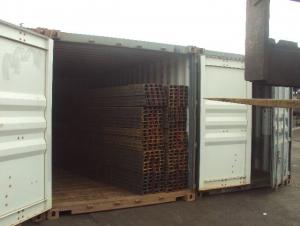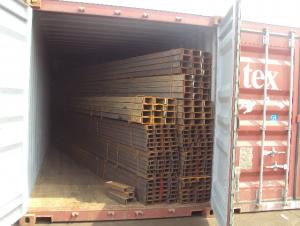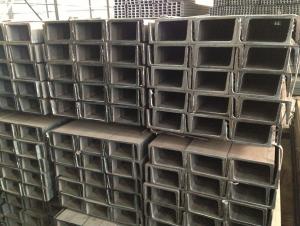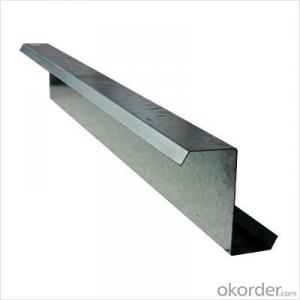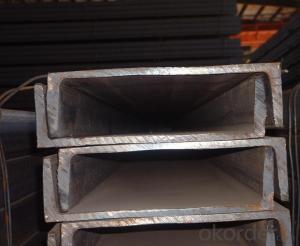U-channel JIS Standard with High Quality
- Loading Port:
- Tianjin
- Payment Terms:
- TT or LC
- Min Order Qty:
- 25 m.t.
- Supply Capability:
- 1000 m.t./month
OKorder Service Pledge
OKorder Financial Service
You Might Also Like
Product Description:
OKorder is offering U-channel at great prices with worldwide shipping. Our supplier is a world-class manufacturer of steel, with our products utilized the world over. OKorder annually supplies products to European, North American and Asian markets. We provide quotations within 24 hours of receiving an inquiry and guarantee competitive prices.
Product Applications:
1.The JIS channel can be devided into two kinds, namely common channel steel and light channel steel. The sizes of hot rolled common channel steel range from 5# to 40#. Meanwhile, the channel steel can be divided into cold forming sectional equal channel steel, cold forming sectional unequal channel steel, cold forming inner edge channel steel and outer edge channel steel.
2.The JIS channel is usually used for arch-itechtural structure, and they could be welded in order to support or hang a vari-ety of facilities. They are also usually used in combination with I beam. The channel steel with sizes under 14# is usually applied to construction engineering, as purline, while the channel steel with sizes above 16# is more likely to be used in building vehicle chassis structure and mechanical structure. Furthermore, the channel steel in sizes above 30# are target at building bridge structure, as tension bar.
3.In a word, the channel steel must possess perfect welding property, riveting property and mechanical property and so on.
Product Advantages:
OKorder's U-channel are durable, strong, and resist corrosion.
Main Product Features:
· Premium quality
· Prompt delivery & seaworthy packing (30 days after receiving deposit)
· Corrosion resistance
· Can be recycled and reused
· Mill test certification
· Professional Service
· Competitive pricing
Product Specifications:
1. We are definitely speciallizing in manufacturing and supplying channel steel as per japanese standard, which is characterised with high mechanical strength and competitive prices.
2. The sections in details are as followings in the table-1
JIS CHANNEL | Standard h | Sectional b | Dimension s | t | Mass: Kg/m |
(mm) | (mm) | (mm) | (mm) | ||
50x25 | 50 | 25 | 3.0 | 6.00 | 2.37 |
75X40 | 75 | 40 | 3.8 | 7.00 | 5.30 |
75X40 | 75 | 40 | 4.0 | 7.00 | 5.60 |
75X40 | 75 | 40 | 4.5 | 7.00 | 5.85 |
75X40 | 75 | 40 | 5.0 | 7.00 | 6.92 |
100X50 | 100 | 50 | 3.8 | 6.00 | 7.30 |
100X50 | 100 | 50 | 4.2 | 6.00 | 8.03 |
100X50 | 100 | 50 | 4.5 | 7.50 | 8.97 |
100X50 | 100 | 50 | 5.0 | 7.50 | 9.36 |
125X65 | 125 | 65 | 5.2 | 6.80 | 11.66 |
125X65 | 125 | 65 | 5.3 | 6.80 | 12.17 |
125X65 | 125 | 65 | 5.5 | 8.00 | 12.91 |
125X65 | 125 | 65 | 6.0 | 8.00 | 13.40 |
150x75 | 150 | 75 | 5.5 | 7.30 | 14.66 |
150x75 | 150 | 75 | 5.7 | 10.00 | 16.71 |
150x75 | 150 | 75 | 6.0 | 10.00 | 17.90 |
150x75 | 150 | 75 | 6.5 | 10.00 | 18.60 |
150x75 | 150 | 75 | 6.5 | 10.00 | 24.00 |
200X80 | 200 | 80 | 7.5 | 11.00 | 24.60 |
FAQ:
Q1: How soon can we receive the product after purchase?
A1: Within three days of placing an order, we will begin production. The specific shipping date is dependent upon international and government factors, but is typically 7 to 10 workdays.
Q2: What makes stainless steel stainless?
A2: Stainless steel must contain at least 10.5 % chromium. It is this element that reacts with the oxygen in the air to form a complex chrome-oxide surface layer that is invisible but strong enough to prevent further oxygen from "staining" (rusting) the surface. Higher levels of chromium and the addition of other alloying elements such as nickel and molybdenum enhance this surface layer and improve the corrosion resistance of the stainless material.
Q3: Can stainless steel rust?
A3: Stainless does not "rust" as you think of regular steel rusting with a red oxide on the surface that flakes off. If you see red rust it is probably due to some iron particles that have contaminated the surface of the stainless steel and it is these iron particles that are rusting. Look at the source of the rusting and see if you can remove it from the surface.
Images:
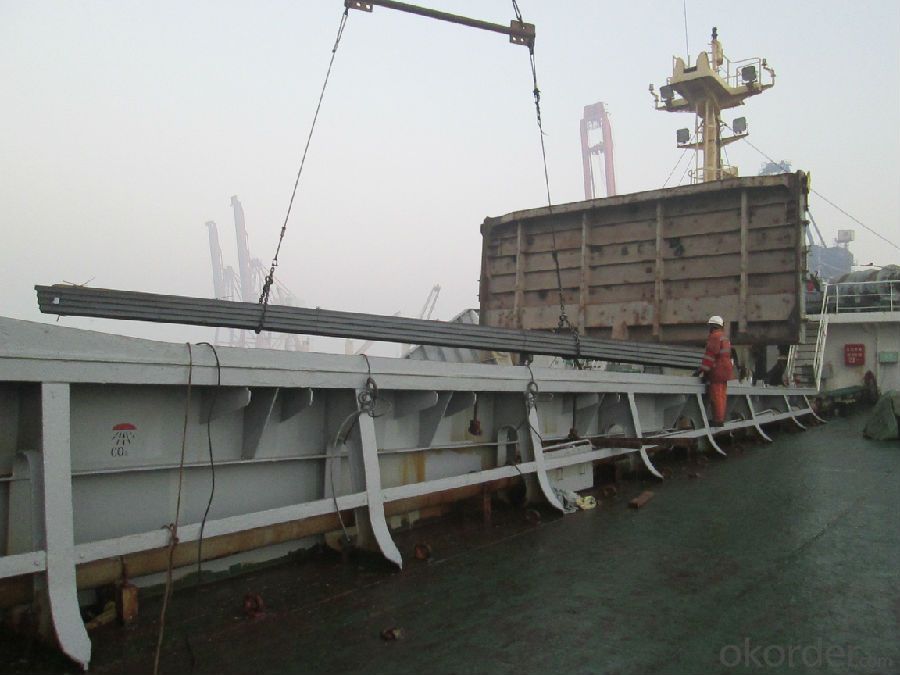
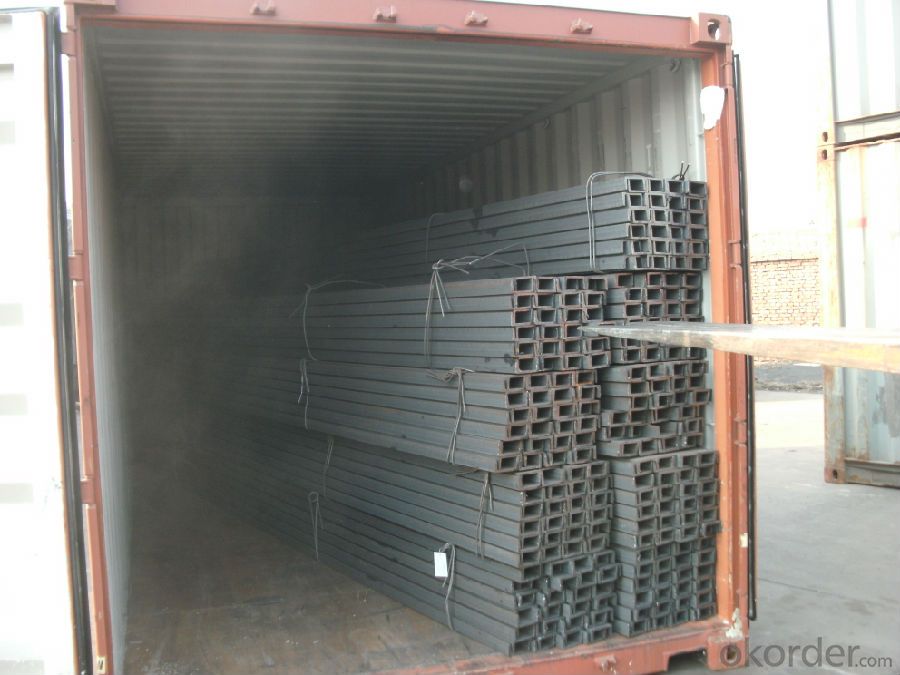
- Q:What is a steel channel?
- A steel channel, which is also known as a C-channel or U-channel, is a steel structural component that has the shape of a "C" or a "U." It is widely used in the construction and manufacturing industries for a variety of purposes. Steel channels are typically made from hot-rolled or cold-formed steel and are available in different sizes and thicknesses to meet various needs. The strength and support provided by the shape of a steel channel make it ideal for structural applications such as framing, bracing, and bearing heavy loads. It is commonly utilized to create beams, columns, and purlins in buildings, bridges, and other infrastructure projects. In manufacturing processes where strength and rigidity are crucial, steel channels are essential. They can be employed as frames, rails, or supports to ensure stability and durability in machinery, vehicles, and equipment fabrication. Moreover, steel channels can serve decorative purposes in architectural designs. They can be integrated into interior or exterior designs to add visual interest, create unique shapes, or achieve a modern industrial look. Overall, a steel channel is a versatile and dependable component that offers strength, support, and flexibility in diverse construction and manufacturing applications.
- Q:Can steel channels be used in telecommunications infrastructure?
- Certainly, telecommunications infrastructure can make use of steel channels. One can commonly find steel channels being employed in the construction of electrical and telecommunications towers, as well as during the installation of various equipment like antennas, cables, and support structures. The inherent strength and durability of steel render it a perfect material for supporting heavy equipment and guaranteeing the stability and longevity of telecommunications infrastructure. Moreover, steel channels can be conveniently customized and fabricated to suit specific requirements, thereby enabling efficient installation and maintenance procedures.
- Q:What is the maximum length of steel channels?
- The length of steel channels can differ based on different factors, including the manufacturer's specifications, transportation restrictions, and practical considerations of handling and installation. Typically, standard lengths for steel channels range from 20 to 40 feet (6 to 12 meters). These lengths are commonly established by the manufacturing process and the equipment's capabilities for cutting and forming the channels. To ascertain the precise maximum length for a specific type of steel channel, it is essential to consult with the manufacturer or supplier.
- Q:How do steel channels contribute to the overall longevity of a structure?
- Steel channels contribute to the overall longevity of a structure by providing structural support and reinforcement. They distribute the weight and load evenly, preventing excessive stress on other components of the structure. Additionally, steel channels have high tensile strength and resistance to corrosion, ensuring that the structure remains strong and durable over time.
- Q:Is the channel 20 the same as the channel 20b?
- No, channel 20, a and B two.20A specifications are: 200*73*7.0, weight per meter is 22.637kg20b specifications are: 200*75*9.0, weight per meter is 25.777kg
- Q:What are the factors to consider when determining the appropriate angle of a steel channel?
- There are several factors to consider when determining the appropriate angle of a steel channel. Firstly, one must take into account the intended purpose or function of the steel channel. Different applications may require different angles. For instance, if the channel is being used as a support or brace, a larger angle may be necessary to ensure sufficient strength and stability. Conversely, if the channel is being used for aesthetic purposes or to create a specific shape, a smaller angle may be more suitable. Secondly, the load that the steel channel will be subjected to is a crucial factor in determining the angle. It is necessary to analyze the weight and distribution of the load to ensure that the chosen angle can withstand the forces and stresses exerted on it. This involves considering factors such as the magnitude and direction of the load, as well as any potential dynamic or impact forces that may be present. Additionally, the material properties of the steel channel should be taken into consideration. Different types of steel have varying strength, durability, and flexibility characteristics. The appropriate angle will depend on the specific properties of the steel being used, as well as any relevant industry standards or regulations. Furthermore, one must consider the fabrication and installation process. The chosen angle should be feasible to manufacture and install, taking into account factors such as cutting, welding, and assembly techniques. It is important to ensure that the angle selected can be easily achieved within the available resources and capabilities. Lastly, cost considerations should not be ignored. Different angles may require varying amounts of steel and fabrication efforts, resulting in different costs. It is essential to balance the desired angle with the available budget in order to make an informed decision. In conclusion, the factors to consider when determining the appropriate angle of a steel channel include the intended purpose, load requirements, material properties, fabrication and installation feasibility, and cost considerations. Taking all these factors into account will help ensure that the selected angle is suitable for the specific application and provides the necessary strength and functionality.
- Q:Can steel channels be galvanized or coated?
- Steel channels can indeed undergo galvanization or coating. Galvanization is a process wherein a layer of zinc is applied to the steel channel's surface to safeguard it against corrosion. This procedure involves dipping the steel channel into molten zinc or utilizing other techniques like electroplating or spraying to apply a zinc coating. By doing so, the zinc coating acts as a barrier between the steel and its surroundings, effectively preventing rusting. Alternatively, coating steel channels presents another option for corrosion protection. There exists a range of coating types, such as epoxy, polyurethane, or powder coatings, which can be applied to the steel channel's surface. These coatings establish a protective layer that shields the steel from moisture, chemicals, and other corrosive elements. Both galvanizing and coating steel channels serve to enhance their durability and extend their lifespan. The decision to employ galvanization or coating relies on various factors, including the intended application, environmental conditions in which the steel channel will be in use, and the desired aesthetic appearance.
- Q:Are steel channels suitable for use in conveyor systems?
- Yes, steel channels are suitable for use in conveyor systems. Steel channels provide strong structural support and are highly durable, making them ideal for use in heavy-duty applications such as conveyor systems. They can withstand heavy loads and can be easily customized to fit specific conveyor requirements. Additionally, steel channels have excellent resistance to wear, corrosion, and temperature fluctuations, ensuring prolonged and reliable performance in conveyor systems.
- Q:Can steel channels be used for creating signage or display structures?
- Indeed, signage or display structures can be fashioned using steel channels. These channels, due to their versatility and durability, are appropriate for a multitude of purposes, including signage and display structures. Their robustness and inflexibility enable the construction of resilient frameworks that can endure harsh outdoor conditions and substantial burdens. Furthermore, steel channels can be effortlessly personalized and manufactured into diverse configurations and dimensions, thus catering to particular design prerequisites. Consequently, they represent an exemplary option for crafting extraordinary and attention-grabbing signage or display structures.
- Q:Can steel channels be used in infrastructure projects?
- Yes, steel channels can be used in infrastructure projects. Steel channels are a versatile and commonly used structural component in construction and infrastructure projects. They are often used to provide support and stability to various structures, such as bridges, buildings, and highways. Steel channels offer several advantages that make them suitable for infrastructure projects. Firstly, they have high strength and durability, which makes them capable of withstanding heavy loads and extreme weather conditions. This ensures the long-term integrity and stability of the infrastructure. Additionally, steel channels can be easily fabricated and customized to meet specific project requirements. They are available in various sizes, shapes, and thicknesses, allowing engineers and architects to design and construct structures with precision. Furthermore, steel channels have excellent corrosion resistance properties. This is crucial in infrastructure projects, especially those exposed to moisture or harsh environmental conditions. Steel channels can be galvanized or coated with protective layers to prevent rust and corrosion, thereby extending their lifespan. Moreover, steel channels provide cost-efficiency. Compared to other construction materials, such as concrete or wood, steel channels have a longer lifespan and require less maintenance. This reduces the overall maintenance and replacement costs of infrastructure projects, making them a cost-effective choice. In conclusion, steel channels are widely used in infrastructure projects due to their strength, durability, customization options, corrosion resistance, and cost-efficiency. They play a crucial role in providing support and stability to various structures, making them a reliable choice for engineers and architects involved in infrastructure development.
1. Manufacturer Overview |
|
|---|---|
| Location | |
| Year Established | |
| Annual Output Value | |
| Main Markets | |
| Company Certifications | |
2. Manufacturer Certificates |
|
|---|---|
| a) Certification Name | |
| Range | |
| Reference | |
| Validity Period | |
3. Manufacturer Capability |
|
|---|---|
| a)Trade Capacity | |
| Nearest Port | |
| Export Percentage | |
| No.of Employees in Trade Department | |
| Language Spoken: | |
| b)Factory Information | |
| Factory Size: | |
| No. of Production Lines | |
| Contract Manufacturing | |
| Product Price Range | |
Send your message to us
U-channel JIS Standard with High Quality
- Loading Port:
- Tianjin
- Payment Terms:
- TT or LC
- Min Order Qty:
- 25 m.t.
- Supply Capability:
- 1000 m.t./month
OKorder Service Pledge
OKorder Financial Service
Similar products
New products
Hot products
Hot Searches
Related keywords


